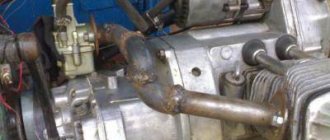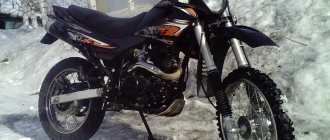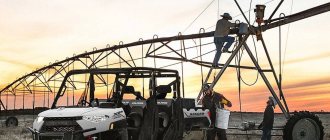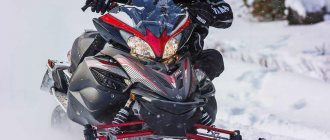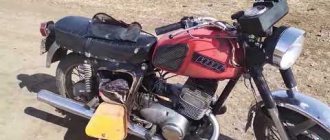The BRP Ski-Doo MXZ Renegade 800R is a snowmobile that is suitable for use in any conditions. The Ski-Doo MXZ 800 series has been on the market for quite some time. The Canadian brand BRP, which is responsible for its development, regularly offers consumers new models with improved characteristics. One of the most popular modifications of the series is the Ski-Doo MXZ Renegade 800R snowmobile (year of appearance: 2011), which combines high speed characteristics and efficiency.
The snowmobile is based on the REV-XS platform. The aluminum track tunnel and pyramidal frame with a rigid structure allow the driver to position himself in the center of mass, which has a positive effect on the handling of the vehicle. The Ski-Doo MXZ Renegade 800R has one of the lightest designs of any product in the brand. The single seat allows the body to move freely over a considerable distance, which improves maneuverability and dynamics.
The chassis of the model can withstand any load perfectly. The front suspension is based on double A-arms, complemented by HPG Plus R gas shock absorbers. An optional quick-release anti-roll bar link is available, which can be installed and removed without additional tools. This technology allows you to quickly change the “tactics” of movement, taking into account specific movement conditions.
Video
At the rear, the new rMotion suspension is fully adjustable with HPG Plus/KYB Pro 36 shocks and can be adjusted in just a few minutes without the need for special tools. Brand representatives claim that the rMotion suspension has the greatest travel among analogues. During its development, priority was given to a comfortable ride on uneven surfaces and reliability when jumping. On heavy terrain, the suspension does not break through, and on hard-packed roads it behaves very softly.
The BRP Ski-Doo MXZ Renegade 800R uses a dedicated PowderMax mountain track. Similar elements are installed on Summit mountain snowmobiles. Due to this, the device seriously improves its cross-country ability.
The powerful engine provides the necessary traction to tackle the most challenging tasks. The device gains high speed in a few minutes. The racing braking system allows you not to be afraid of the movement process, making it as safe as possible.
The BRP Ski-Doo MXZ Renegade 800R stands out from other snowmobiles with its stylish design. An interesting combination of colors and an original body make us pay special attention to it.
The basic package of the model includes:
- straight aluminum handlebar with J-handles;
- fuel level indicator;
- electric starter;
- narrowed REV-XP X seat with luggage compartment;
- windshield (size – 152 mm);
- speedometer;
- multifunctional digital information center;
- heated handles;
- tachometer.
Options include rear-view mirrors, an additional seat, a backrest and a tow bar.
The BRP Ski-Doo MXZ Renegade 800R is a real beast that can wade through large snowdrifts, jump from steep banks onto ice, move over rough terrain and maneuver through the forest. This snowmobile is a dream come true for any consumer.
Specifications
- Dimensions, mm: Length – 3110, Width – 1217, Height – 1200
- Ski base – 1077 mm
- Track dimensions, mm: Length/width – 3487/406
- Grouser height – 31.8 mm
- Dry weight – 218 kg
- Single seat – yes (basic version)
- Front suspension - wishbone, with travel of 229 and 406 mm front and rear, respectively
- Transmission:
- Drive/Driven CVT Pulley – TRA VII/QRS
- Reverse – yes
- The brakes are sports from Brembo.
Engine
The BRP Ski-Doo MXZ Renegade 800R is powered by a reliable Rotax 800 HO Power TEK 2-stroke engine. The unit operates incredibly quietly and smoothly, sounding more like a 4-stroke unit. The engine's smoke emissions and emissions of harmful elements are minimal for this class.
The engine uses modern direct injection, which makes it very economical (average consumption 15 l/100 km). Another advantage of the engine is the ease of starting and the ease of pressing the gas handle. There is no need to prepare the unit for the rest period, since it has an automatic preservation function.
Rotax 800 HO Power TEK Engine Specifications:
- working volume – 799.5 cc;
- rated power - 137 hp;
- number of cylinders – 2 (in-line arrangement);
- cylinder diameter – 82 mm.
Unit features:
- fuel system - injection;
- cooling system – liquid;
- ignition system – CDI magneto.
- emergency engine switch – present.
Fuel tank capacity – 40 l, oil tank – 3.5 l.
Price and where to buy
The cost of a new snowmobile is 1,320,000 Russian rubles. Official dealers of the manufacturing company provide sales and fast delivery to all cities of the Russian Federation and neighboring countries. Delivery in Moscow and the nearest Moscow region is free; for other regions, the cost of postal or courier services must be added to the price of the snowbike (on average +1500-3500 rubles).
A used model will cost 890,000-910,000 rubles. depending on the number of operating hours and general technical condition. A used BRP Ski-Doo MXZ Renegade 800R usually requires repair. Here are approximate prices for some spare parts suitable for this model of snow bike (cost in rubles):
| Inlet pipe | 4500 |
| Suspension spring | 1450 |
| Front variator shaft bracket | 4500 |
| Steering shaft | 10500 |
| Brake pads | 5300 |
| Underbody protection | 11000 |
| Extended brake hose | 2000 |
| Stretcher | 35000 |
| Fuel tank cap with key | 3300 |
| Mirrors | 3100 |
Owner reviews
- Ali1687: I bought a Renegade 800 3 years ago. The impressions from its use are twofold. After 140 km the spark plug burned out. I dealt with this problem quite quickly. However, after 100 km, a friend began to hear a noise during a slow start, then a cracking sound began to be heard under the seat. During acceleration, extraneous sounds disappear. The service center said that the equipment just needs to be warmed up. I put it in the garage, but the crackling and noise remained. As long as I drive like this, it doesn’t affect the functionality in any way. In terms of speed characteristics, the 800th Renegade is very good, as well as in terms of efficiency (consumption does not exceed 20 liters under any operating conditions and loads).
- Mikhail, Vladivostok: Ski-Doo MXZ Renegade 800R, as it turned out, is not the best model of the Canadian brand. I owned it for 2 years. Over 500 km of travel, the spark plugs had to be changed 2 times. The device works very unevenly. Sometimes the speed suddenly drops, the tachometer drops almost to zero, but the engine does not stall. Moreover, this happens even on warmed-up equipment, when it has already traveled several kilometers. When you start, you hear strange clicks from your left leg. At high speeds there is quite a lot of vibration. I didn't really like Snowball. After having to change the belt at the end of the second year, I sold it.
- Anton, Saransk: Gad 800 from a friend, he bought it 3-4 years ago. We live nearby, so we took it for a ride several times. The technology is not bad in principle, but very expensive. I drove it through the forest and across the field. Consumption was approximately 14 liters per hundred. Once I ran into a snag that was hiding in the snow. Snezhik survived such a collision, dented his ski a little, but there was no damage. I liked the controls of the Gad 800. The steering wheel moves easily, the technology listens to the driver, and acceleration is generally excellent. A friend says there have been no serious breakdowns so far, and he is happy with the equipment.
- Vitaly_1985: I've been riding the MXZ Renegade 800R since 2013. Today the mileage is 2500 km. I'm happy with the snowmobile. The device carries as much as is loaded on it. It goes smoothly, without failures. At the same time, it is light and dynamic, and the consumption is 13-15 l/100 km. It has all the options for driving in winter: heated handles, a powerful battery, rear-view mirrors. I did minimal snowballing. The problem only happened once. When I put the vehicle in reverse, the headlights suddenly stopped working. The reason for this turned out to be a blown fuse. I bought a new one, installed it, cleaned the block itself, the motor stopped working. In the end I had to remove the fuse, so that's how I drive for now. Otherwise the snowball is perfect.
Test drive BRPRenegade 800 X
Why utilitarian quadras exist is clear. Mix mud in a nearby swamp, go “by azimuth” to the village to visit your grandmother, kill a couple of innocent animals, or, in the end, bring hay to the dacha. The purpose of sports quads is also beyond doubt - they are made for driving along the “start-podium” route.
But a product called the BRP Renegade 800 at first caused some confusion among the public: a trailer with fertilizers, perhaps, to be dragged between races on the cross-country track?
No, the Renegade is equidistant from both the cross-country track and the trailer with manure, being one of the best representatives of the “recreational” class of ATVs. Apparently, at some point, the BRP concern got tired of the fact that their 60-horsepower utilitarian ATVs were considered almost farm equipment. Strongly offended, the engineers shouted “fuck farmer!” rushed to draw up a plan for revenge. The solution was found quite quickly. A shortened chassis with an engine and transmission from a utilitarian ATV was taken and packaged in a “sporty” body kit. Thus, the form was brought into line with the essence, and no one dared to call such a technique “farming.”
After the BRP Renegade 800 was “tested” by the public and received its share of flattering epithets in the press, the manufacturer began to clearly point the finger at its utilitarian models. The hint was simple: Is the Renegade 800 fast, sharp and sporty? But its filling is almost the same as that of the Outlander 800! Thus, the BRP concern killed three birds with one stone: it introduced a new model to the market, filled an empty niche and got rid of the “farmer” stigma.
The BRP Renegade 800 is beautiful. The clearly defined edges of the plastic body kit merge into a harmonious man-made composition. In some ways it looks like equipment from science fiction films, and a couple of plasma dischargers just beg to be inserted into the plastic cutouts.
But the most interesting thing is hidden under the futuristic black and yellow cladding elements.
First up is the fiery Rotax 4-Tec V-800 HO, a 799cc liquid-cooled V-twin engine that produces 65 horsepower. This engine debuted in 2006 in the Outlander Max 800. Then it migrated to the Lynx and Ski-Doo series of snowmobiles, and since 2007 it has become the heart of the Renegade. The engine is combined with an electronically controlled variator (CVT), which also migrated to the new model from its utilitarian “ancestor”. The only change made is a different control program, which implements a sharper response of the ATV to the gas.
Secondly, the Renegade 800 gets its own suspension. The wheels swing on double A-arms. Moreover, the upper arm is molded from aluminum using isothermal casting. Unlike utilitarian models, the Renegade shock absorbers have a full range of adjustments. This allows the suspension to be adapted to any type of surface and any driving style.
Somehow it’s not good that I tell all the most interesting things “while standing still.” So, let's sit down, start the engine and go!
It feels like the engineers tried to make the ATV small. First of all, this affects the pilot’s “workplace”. No, it cannot be called cramped - the epithet “compact” is more suitable here. The driver is provided with exactly the amount of space needed for active riding. You don’t have to make a lot of body movements to move your body back and forth on ups and downs. Well, when cornering, the design provides enough space for the driver to hang over without feeling like he’s sitting on a children’s tricycle.
If you take your mind off the “fir-pine trees” flashing on both sides of the forest road and look lower, you can see the LCD display, which is a fully functional dashboard. Speedometer, odometer, fuel gauge, engine hour meter... In general, a complete gentleman's set that you look at just for the sake of interest.
Now, about the most exciting thing (no, we’ll talk about beer and women’s charms another time!). Namely, about the engine. As mentioned above, the Renegade is powered by an engine from the utilitarian Outlander Max 800. If the reader remembers, I spoke flatteringly about this engine, praising it for its good traction and bright sporty features. Having moved to a new chassis, the power unit not only retained them, but also acquired new, even brighter ones.
While I was riding at half throttle, this Rotax seemed heavy and harsh to me. The true character of the engine was revealed after I fully depressed the throttle trigger at the exit of a gentle turn. There was a feeling that the “Renegade” had gone berserk: the wheels instantly tore into the axle boxes, despite the fairly high speed. From the area of the air filter there was a sound reminiscent of a turbine gaining speed, and from the exhaust side the howl of the Jericho trumpet sounded. At the same time, the acceleration was as if the engine suddenly switched from atmospheric mode to “boost”.
Despite its wild temper, the engine follows the throttle trigger well. However, it shouldn’t be otherwise, because two Siemens VDO injectors with a 46 mm throttle body are responsible for mixture formation.
The most interesting thing is that the nameplate power and torque indicators of the Renegade are almost no different from those of the Outlander Max 800. The trick is that this model uses a different program for the operation of an electronically controlled variator, which fully implements the intended designers determine the sharpness of the engine. Also, consider the much lighter weight of this BRP.
Brakes equipped with reinforced lines help to settle the well-heated BRP. Up front are two 220mm discs paired with dual-piston calipers. The rear multi-disc brake is of a “wet” type and, according to tradition, is located in the rear axle housing. Judging by the characteristic sounds, the service life of its pads on this example has come to an end, therefore, the deceleration process was “three plus”.
The short-wheelbase chassis makes a huge contribution to handling. The ATV responds more sharply to any steering movement or change in weight distribution. On bumpy straights it is not as stable as longer specimens, but it makes up the points in corners. Thanks to the presence of front and rear anti-roll bars, the Renegade almost does not sag on the outer pair of wheels. However, in order to feel confident in a power skid, you need to accurately monitor the roll, speed, degree of skidding and the type of soil under the wheels - this ATV does not like pilot mistakes. And he doesn’t forgive.
Ski jumping is a separate discipline. After experimenting with speed and launch angles, I felt that the Renegade was too heavy for such entertainment. It’s not even a matter of the suspension, which perfectly executes the “landing” process. The problem is that if the “take-off” did not go as planned, and in the air the ATV begins to turn along the longitudinal or transverse axis, then returning it to a horizontal position before landing is not easy.
Of course, if we compare the “Renegade” with the utilitarian 350-kilogram “barges”, then in this discipline it will give them a hundred points ahead. And it will lose by the same number of points in comparison with light sports quads.
Having ridden in the style of rally raids, I went deeper into the forests of the middle zone to look for adventure there. I didn’t plan to find a swamp or even a small puddle after months of stupefying heat - even in the shade of trees, the soil was completely dry and cracked. Therefore, to get an idea of the Renegade’s cross-country ability, I had to leave the forest road and go to where the thickets are thicker and the terrain is more difficult.
On steep descents and ascents, the ATV tends to tumble - alas, this is inevitable with a short wheelbase and a high center of gravity. But in confined spaces you notice its excellent maneuverability and small turning radius. Even in a dense forest, I did not experience discomfort - the quad easily snuck around where some two-seater utilities would have stopped for a long time. In the dense undergrowth, I was glad to see the standard handlebar protection. Even though I was wearing leather gloves with an abundance of carbon inserts, when branches whip across my fingers, it’s still not very pleasant.
A pleasant surprise was that this ATV behaves quite confidently in difficult terrain. From the utilitarian he inherited not only the engine, but also the transmission with all its features. On flat terrain, the Renegade is fun to drive with rear-wheel drive, skidding through corners. As the terrain becomes more difficult, you can switch to all-wheel drive and a low range. Moreover, the differential lock will be activated automatically, thanks to the Visco-Lok system. If this were a utilitarian technique, I would certainly note that on a real offroad device, all locks must be manual. But, since this BRP does not pretend to be a “mud stirrer,” you can close your eyes to this.
If you don’t get carried away with storming stumps, then you don’t have to worry about the integrity of the suspension elements: to protect the levers, the owner installed shields made of thick fiberglass - a durable and lightweight material. Well, the bottom is protected by sheets of stamped aluminum. I deliberately left the main (and only) drawback I noticed for last, so as not to spoil the reader’s overall impression of the technology. As on the Outlander Max 800, the Renegade's transmission mode selector is very tight and unclear. Apparently, this specimen also had a rich and colorful past, which influenced the premature wear of the unit.
Since the test drive ended before dark, I was never able to evaluate the 4-lens 60-watt head light. But, I believe that it will be enough for orientation in the dark, if you don’t rush through the forest “at full blast.”
When concluding an article, it is customary to state the conclusion, summarize, or simply write a lot of smart text. In this case this will not happen. If only because it is banal. No, I’m not at all lazy to spend another five minutes of time at the keyboard, but the result will be a shortened and generalized repetition of all of the above with a thick admixture of the author’s subjectivity. I believe the reader has already formed his opinion about the BRP Renegade 800, which is no worse than mine. In addition, a person who has held the MotoDrive magazine in his hands more than once understands well why such equipment is purchased and how it is used.
Well, I wrote a lot of smart text again...
Text: Sergey Kuznetsov
Photo: Ilya Pshenichny
The ATV was provided for testing by Vadim Singovsky
Improvements
Ski-Doo engineers designed special side panels that literally slide through the snow, preventing it from accumulating on the tunnel, thereby slowing the sled. Additionally, the side panels make sidehilling easier, aided by the tMotion suspension and Flexedge track.
The Renegade Backcountry also features the LINQ accessory bag attachment system. Ski-Doo's accessories catalog offers a wide selection of bags, canisters, and even ski or snowboard bindings.
Considering the fact that snow accumulating in the footpegs can significantly increase the weight of the snowmobile, Ski-Doo designers included large holes in them to dump snow. The footpegs are also grippy enough that your boots won't slip anywhere.
Manufacturers noticed many years ago that by not painting the tunnel, significant weight savings could be achieved. This lack of paint trend continued for several seasons. Interestingly, engineers later discovered that more snow accumulated on an unpainted tunnel, so the manufacturers decided that it was better to increase the dry weight than to significantly increase the operating weight.
Controllability
During our test drive, we found the Renegade to be very comfortable on the highway and handles corners well. The skis do not fall into another ski track. The 800cc engine is powerful enough to pull the sled through any corner. The Cobra Flexedge track, with 1.6-inch lugs, has the traction to keep every horsepower on the snow on most trails. Although the Renegade Backcountry is built on the REV-XM mountain chassis, it is more of a trail machine in terms of performance. But the height of the lugs is inadequate. The 1.6-inch lugs don't provide much traction on soft snow, although the 146-inch length is average for crossover sleds. The 146-inch track is long enough if the ridges are high enough, but 1.6 inches just isn't enough to tackle serious off-road terrain.
Driving a snowmobile with a track that's shorter than a regular mountain snowmobile requires a little different handling to keep up with other mountain machines. The driver can take advantage of the tracks, but there is a slight difficulty - he will have to move faster. But not all terrain allows you to go fast. If potential Renegade Backcountry owners give up the illusion that they can compete with mountain snowmobile riders, they will be very happy with their choice. Crossovers like the Backcountry are a compromise between mountain and trail design.
Ski-Doo renegade backcountry 800r chassis
Ski-Doo built its Renegade Backcountry snowmobile on the REV-XM chassis, which is a mountain chassis. Although the Renegade Backcountry and Summit share the same platform at the base, the former has wider ski spacing and a shorter track. On average, the Summit ranges in width from 889mm to 940mm, while the Renegade ranges from 965mm to 1016mm. So even if you set the skis to the closest position, the Renegade's front end will still be wider than the Summit's.
What does it mean? This means the Renegade won't hold up on slopes like the Summit, and it'll be harder to get into a tight turn than the MXZ. That's the whole point of crossovers—somewhere in the middle.

